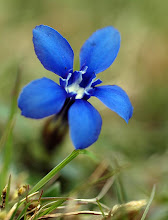Looking like a writhing python – but less than a millimetre long – this nematode worm came from water that I squeezed out of a patch of wet moss. It was photographed using polarised light, which generates the interference colours you can see here; the bottom image is nearer to the true appearance – most small nematodes are transparent.
Nematodes – commonly known as roundworms – are ubiquitous and there are thought to be about half a million species, which may well be a conservative estimate. Some live freely in the soil or in fresh or salt water, some are predators, many are parasites of animals and plants and several species cause serious damage to the roots of crop plants.
One microscopically-small species, called Phasmarhabditis hermaphrodita is a parasite of slugs and is commercially available in garden centres for killing these garden pests. Another species, a parasite of sperm whales, grows to a length of 9 metres. A square metre of fertile soil will contain several million nematodes. A single rotting apple was once found to contain 90,000 individuals.
One nematode species, called Caenorhabditis elegans, is used by biologists for investigating the way in which a complex animal develops from a single fertilised egg. Its transparency allows biologists to follow and map the fate of every cell in its body during its development. Amazingly, consignments of this species that were part of an experiment in space were recovered alive in the wreckage of the space shuttle Columbia, which disintegrated during re-entry into Earth’s atmosphere in 2003 (see http://news.bbc.co.uk/1/hi/sci/tech/2992123.stm)


















No comments:
Post a Comment
Note: Only a member of this blog may post a comment.